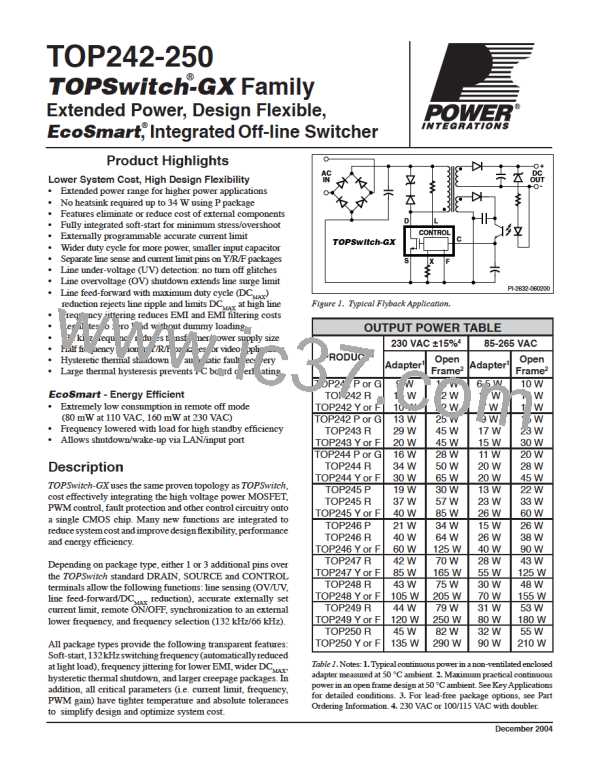TOP242-250
However, VR1 is essential to limit the peak drain voltage
during start-up and/or overload conditions to below the 700 V
rating of the TOPSwitch-GX MOSFET.
A High Efficiency, 250 W, 250-380 VDC Input Power Supply
The circuit shown in Figure 43 delivers 250 W (48 V @
5.2 A) at 84% efficiency using a TOP249 from a 250 VDC to
380 VDC input. DC input is shown, as typically at this power
levelap.f.c.booststagewouldpreceedthissupply,providingthe
DC input (C1 is included to provide local decoupling). Flyback
topology is still usable at this power level due to the high output
voltage, keeping the secondary peak currents low enough so
that the output diode and capacitors are reasonably sized.
The secondary is rectifed and smoothed by D2 and C9, C10 and
C11. Three capacitors are used to meet the secondary ripple
current requirement. Inductor L2 and C12 provide switching
noise filtering.
A simple Zener sensing chain regulates the output voltage.
The sum of the voltage drop of VR2, VR3 and VR4 plus the
LED drop of U2 gives the desired output voltage. Resistor R6
limits LED current and sets overall control loop DC gain.
Diode D4 and C14 provide secondary soft-finish, feeding
current into the CONTROL pin prior to output regulation and
thus ensuring that the output voltage reaches regulation at start-
up under low line, full load conditions. Resistor R9 provides a
discharge path for C14. Capacitor C13 and R8 provide control
loop compensation and are required due to the gain associated
with such a high output voltage.
In this example, the TOP249 is at the upper limit of its power
capability and the current limit is set to the internal maximum
by connecting the X pin to SOURCE. However, line sensing
is implemented by connecting a 2 MΩ resistor from the L pin
to the DC rail. If the DC input rail rises above 450 VDC, then
TOPSwitch-GX will stop switching until the voltage returns to
normal, preventing device damage.
Due to the high primary current, a low leakage inductance
transformer is essential. Therefore, a sandwich winding with
a copper foil secondary was used. Even with this technique,
the leakage inductance energy is beyond the power capability
of a simple Zener clamp. Therefore, R2, R3 and C6 are added
in parallel to VR1. These have been sized such that during
normal operation, very little power is dissipated by VR1,
the leakage energy instead being dissipated by R2 and R3.
Sufficient heat sinking is required to keep the TOPSwitch-GX
device below 110 °C when operating under full load, low line
and maximum ambient temperature. Airflow may also be
required if a large heatsink area is not acceptable.
C7
2.2 nF Y1
D2
MUR1640CT
R2
68 kΩ 68 kΩ
2 W 2 W
R3
C6
4.7 nF
1 kV
C10
560 µF 560 µF
63 V 63 V
C11
L2
3 µH 8A
+250-380
VDC
VR1
P6KE200
48 V@
5.2 A
C9
560 µF
63 V
C12
68 µF
63 V
D1
BYV26C
RTN
D2
1N4148
U2
LTV817A
R1
2 MΩ
1/2 W
R9
10 kΩ
T1
C4
1 µF
50 V
C1
22 µF
400 V
R6
100 Ω
TOPSwitch-GX
C13
150 nF
63 V
D
S
L
TOP249Y
U1
D4
PERFORMANCE SUMMARY
1N4148
CONTROL
C
Output Power:
Line Regulation:
Load Regulation:
Efficiency:
250 W
VR2 22 V
BZX79B22
± 1%
± 5%
≥ 85%
R4
C14
22 µF
63 V
X
F
6.8 Ω
VR3 12 V
BZX79B12
C3
R8
56 Ω
Ripple:
< 100 mV pk-pk
0.1 µF
C3
47 µF
10 V
No Load Consumption: ≤ 1.4 W (300 VDC)
50 V
VR4 12 V
BZX79B12
0 V
All resistor 1/8 W 5% unless
otherwise stated.
PI-2692-081204
Figure 43. 250 W, 48 V Power Supply using TOP249.
M
22 12/04

 POWERINT [ Power Integrations ]
POWERINT [ Power Integrations ]